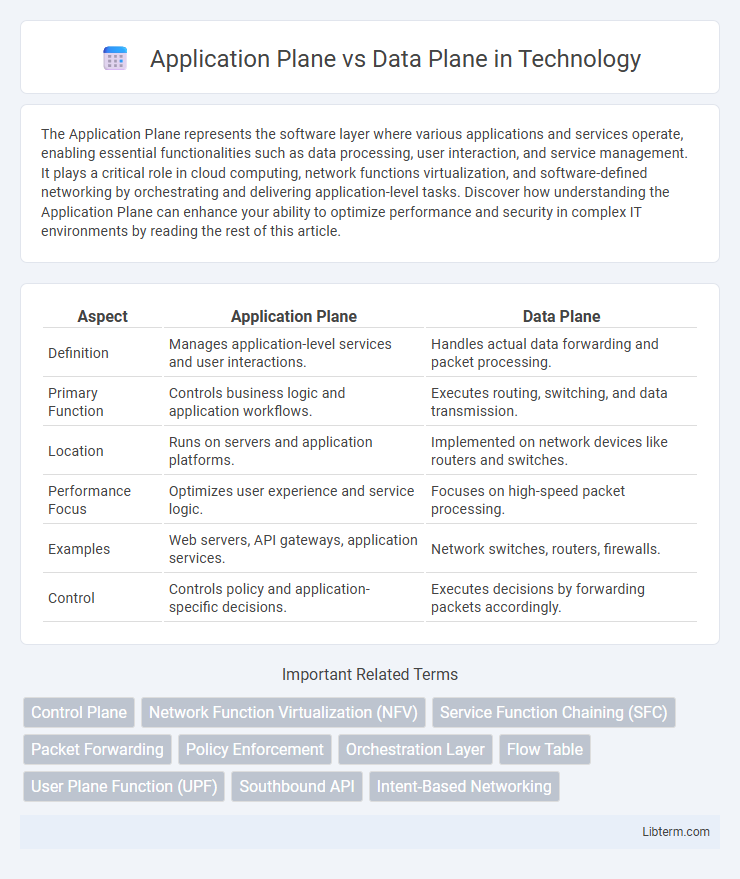The Application Plane represents the software layer where various applications and services operate, enabling essential functionalities such as data processing, user interaction, and service management. It plays a critical role in cloud computing, network functions virtualization, and software-defined networking by orchestrating and delivering application-level tasks. Discover how understanding the Application Plane can enhance your ability to optimize performance and security in complex IT environments by reading the rest of this article.
Table of Comparison
| Aspect | Application Plane | Data Plane |
|---|---|---|
| Definition | Manages application-level services and user interactions. | Handles actual data forwarding and packet processing. |
| Primary Function | Controls business logic and application workflows. | Executes routing, switching, and data transmission. |
| Location | Runs on servers and application platforms. | Implemented on network devices like routers and switches. |
| Performance Focus | Optimizes user experience and service logic. | Focuses on high-speed packet processing. |
| Examples | Web servers, API gateways, application services. | Network switches, routers, firewalls. |
| Control | Controls policy and application-specific decisions. | Executes decisions by forwarding packets accordingly. |
Introduction to Application Plane and Data Plane
The Application Plane handles network services and functions that directly support user applications, enabling control and management of traffic behavior through policies and software interfaces. The Data Plane, also known as the forwarding plane, is responsible for the actual movement of packets based on rules defined by the control or application planes, ensuring efficient data transfer across network devices. Understanding the distinct roles of these planes is crucial for optimizing network performance and implementing software-defined networking (SDN) architectures.
Core Functions of the Application Plane
The Application Plane primarily manages network services by providing end-user applications with interfaces for communication, control, and policy enforcement. It processes business logic, handles orchestration, and performs service management to ensure efficient resource utilization and customization. Core functions include routing decisions, traffic engineering, and network analytics, which drive the underlying Data Plane's packet forwarding processes.
Core Functions of the Data Plane
The Data Plane primarily handles packet forwarding and processing tasks within a network, ensuring efficient and rapid transmission of data packets between devices. It executes functions such as packet switching, forwarding, filtering, and encapsulation based on predefined rules or forwarding tables established by the Control Plane. High-performance hardware like network interface cards (NICs) and ASICs often support the Data Plane to achieve low latency and high throughput essential for core network operations.
Key Differences Between Application Plane and Data Plane
The Application Plane manages network services and protocols, enabling user interaction and application-specific functions, while the Data Plane handles the actual forwarding of packets based on routing decisions. The Application Plane operates at a higher abstraction level, processing control logic and policy enforcement, whereas the Data Plane executes low-level packet forwarding and traffic handling. Performance in the Data Plane is critical for speed and efficiency, contrasting with the Application Plane's focus on decision-making and network management.
Role in Network Architecture
The Application Plane manages network services and user-facing functions, enabling the execution of applications and policy enforcement. The Data Plane handles packet forwarding, routing, and processing, ensuring efficient data transfer across devices. Together, these planes separate control and forwarding functions, optimizing network performance and scalability.
Security Implications in Each Plane
The Application Plane processes user-facing services and applications, making it a prime target for attacks such as code injection, unauthorized access, and data exfiltration, requiring robust authentication, input validation, and secure API management. The Data Plane handles the actual packet forwarding and routing, where vulnerabilities can lead to traffic interception, denial-of-service, or routing manipulation, necessitating strong encryption, integrity checks, and real-time anomaly detection. Security strategies must tailor controls specifically to the threats characteristic of each plane to maintain overall network integrity and confidentiality.
Performance Considerations: Application vs Data Plane
The application plane handles high-level logic and control functions, often introducing processing overhead that impacts overall network latency and throughput. The data plane focuses on fast packet forwarding and is optimized for performance with hardware acceleration and minimal processing delay. Efficient separation of the application and data planes enhances network performance by offloading computational tasks from the data plane, ensuring rapid data transmission and reducing bottlenecks.
Use Cases and Real-World Examples
The Application Plane manages user-facing services such as web browsers, email clients, and cloud applications by processing high-level functions and business logic. The Data Plane handles the actual movement of packets through routers, switches, and firewalls, supporting use cases like traffic forwarding and network security. In real-world scenarios, software-defined networking (SDN) separates these planes, allowing centralized control in the Application Plane to dynamically manage traffic in the Data Plane for optimized network performance and security enforcement.
Challenges and Best Practices
The Application Plane faces challenges in ensuring seamless integration and real-time processing of diverse services, while the Data Plane struggles with maintaining high throughput and low latency for massive data traffic. Best practices for optimizing the Application Plane include modular design and API standardization to enhance scalability and interoperability. For the Data Plane, implementing efficient packet forwarding algorithms and hardware acceleration techniques helps meet performance and reliability demands.
Future Trends in Plane Separation
Future trends in plane separation emphasize enhanced automation and artificial intelligence integration within the Application Plane to enable dynamic policy management and real-time network optimization. The Data Plane advances with programmable hardware and in-network processing capabilities, supporting higher throughput and lower latency for critical applications. Emerging architectures, such as intent-based networking and edge computing, further drive the decoupling of control, application, and data functions to maximize scalability and flexibility in complex network environments.
Application Plane Infographic

 libterm.com
libterm.com